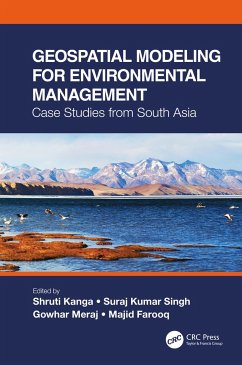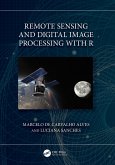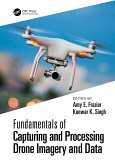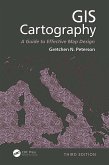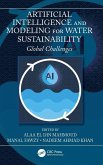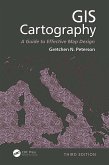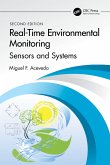Geospatial Modeling for Environmental Management
Case Studies from South Asia
Herausgeber: Kanga, Shruti; Meraj, Gowhar; Singh, Suraj Kumar
Geospatial Modeling for Environmental Management
Case Studies from South Asia
Herausgeber: Kanga, Shruti; Meraj, Gowhar; Singh, Suraj Kumar
- Gebundenes Buch
- Merkliste
- Auf die Merkliste
- Bewerten Bewerten
- Teilen
- Produkt teilen
- Produkterinnerung
- Produkterinnerung
This is a comprehensive resource that integrates the application of innovative remote sensing techniques and geospatial tools in modeling Earth systems for environmental management beyond customary digitization and mapping practices
Andere Kunden interessierten sich auch für
![Lake Functioning Lake Functioning]() Gertrud K. NurnbergLake Functioning125,99 €
Gertrud K. NurnbergLake Functioning125,99 €![Remote Sensing and Digital Image Processing with R Remote Sensing and Digital Image Processing with R]() Marcelo de Carvalho Alves (Brazil Federal University of Lavras)Remote Sensing and Digital Image Processing with R186,99 €
Marcelo de Carvalho Alves (Brazil Federal University of Lavras)Remote Sensing and Digital Image Processing with R186,99 €![Fundamentals of Capturing and Processing Drone Imagery and Data Fundamentals of Capturing and Processing Drone Imagery and Data]() Fundamentals of Capturing and Processing Drone Imagery and Data59,99 €
Fundamentals of Capturing and Processing Drone Imagery and Data59,99 €![GIS Cartography GIS Cartography]() Gretchen N. Peterson (PetersonGIS, Seattle, Washington, USA)GIS Cartography64,99 €
Gretchen N. Peterson (PetersonGIS, Seattle, Washington, USA)GIS Cartography64,99 €![Artificial Intelligence and Modeling for Water Sustainability Artificial Intelligence and Modeling for Water Sustainability]() Artificial Intelligence and Modeling for Water Sustainability169,99 €
Artificial Intelligence and Modeling for Water Sustainability169,99 €![GIS Cartography GIS Cartography]() Gretchen N. Peterson (PetersonGIS, Seattle, Washington, USA)GIS Cartography114,99 €
Gretchen N. Peterson (PetersonGIS, Seattle, Washington, USA)GIS Cartography114,99 €![Real-Time Environmental Monitoring Real-Time Environmental Monitoring]() Miguel F. AcevedoReal-Time Environmental Monitoring105,99 €
Miguel F. AcevedoReal-Time Environmental Monitoring105,99 €-
-
-
This is a comprehensive resource that integrates the application of innovative remote sensing techniques and geospatial tools in modeling Earth systems for environmental management beyond customary digitization and mapping practices
Produktdetails
- Produktdetails
- Verlag: Taylor & Francis Ltd
- Seitenzahl: 366
- Erscheinungstermin: 16. Februar 2022
- Englisch
- Abmessung: 234mm x 156mm x 22mm
- Gewicht: 766g
- ISBN-13: 9780367702892
- ISBN-10: 0367702894
- Artikelnr.: 62606274
- Herstellerkennzeichnung
- Libri GmbH
- Europaallee 1
- 36244 Bad Hersfeld
- gpsr@libri.de
- Verlag: Taylor & Francis Ltd
- Seitenzahl: 366
- Erscheinungstermin: 16. Februar 2022
- Englisch
- Abmessung: 234mm x 156mm x 22mm
- Gewicht: 766g
- ISBN-13: 9780367702892
- ISBN-10: 0367702894
- Artikelnr.: 62606274
- Herstellerkennzeichnung
- Libri GmbH
- Europaallee 1
- 36244 Bad Hersfeld
- gpsr@libri.de
Shruti Kanga is an associate professor and coordinator at the Center for Climate Change and Water Resources, Suresh Gyan Vihar University, Jaipur, India. Previously she was an assistant professor at Central University of Jharkhand (CUJ), Ranchi and also served as Research Associate in Ministry of Environment, Forest and Climate Change (MoEF). She received her PhD in 2013 from the Department of Remote Sensing, Birla Institute of Technology, Ranchi. She has worked in the areas of forest fires risk modeling and management, tourism, resource management etc. Suraj Kumar Singh is an associate professor and coordinator at the Center for Sustainable Development, Suresh Gyan Vihar University, Jaipur. Previously he worked as an assistant professor at the Central University of Jharkhand (CUJ), Ranchi. He has also served as Research Associate in National Remote Sensing Center (NRSC), Indian Space Research Organization (ISRO). He earned his Ph.D. degree in 2012 from the Department of Remote Sensing, Birla Institute of Technology, Ranchi. He has experience in the area of water logging and flood hazards, geospatial applications in water resources, disaster management, hydrogeomorphology, urban planning and wasteland mapping. Gowhar Meraj is a Young Scientist Fellow, in the Department of Science and Technology, Government of India's Scheme for Young Scientist and Technologists (SYST) at Department of Ecology, Environment, and Remote Sensing, Government of Jammu and Kashmir. Previously he worked at the Ministry of Environment, Forests, and Climate Change (MoEF&CC) and as a consultant with World Bank Group, New Delhi for its South Asia Water Initiative Program. He has done his M Phil. and M Sc. in Environmental Sciences from the University of Kashmir, India. He has more than nine years of experience in research and teaching in various themes related to satellite remote sensing and GIS. He has published over 40 articles in various international and national journals. Majid Farooq is a scientist at the Department of Ecology, Environment, and Remote Sensing, Government of Jammu and Kashmir, India. He has more than 15 years of experience in research, teaching and consultancy related to remote sensing and GIS such as climate change vulnerability assessments, flood modeling, ecosystem assessment, watershed management, natural resource management, ecosystem services, and modeling. He has over 25 publications in various international and national journals.
PART A Geospatial Modeling in Hydrological Studies
Chapter 1 Flood Vulnerability and Risk Assessment with Parsimonious
Hydrodynamic Modeling and GIS
Chapter 2 Estimation of Parameters in Ungauged Catchment Using Map-
Correlation Method: A Case Study on Krishna-Godavari Basin
Chapter 3 Soil and Water Assessment Tool for Simulating the Sediment and
Water Yield of Alpine Catchments: A Brief Review
Chapter 4 Temporal Assessment of Sedimentation in Siruvani Reservoir Using
Remote Sensing and GIS
Chapter 5 Review of Conceptual Models of Estimating the Spatio-Temporal
Variations of Water Depth Using Remote Sensing and GIS for the Management
of Dams and Reservoirs
PART B Geospatial Modeling in Landslide Studies
Chapter 6 Geospatial Modeling in Landslide Hazard Assessment: A Case Study
along Bandipora-Srinagar Highway, N-W Himalaya, J&K, India
Chapter 7 Causes, Consequences and Mitigation of Landslides in the
Himalayas: A Case Study of District Mandi, Himachal Pradesh
Chapter 8 Landslide Hazard and Exposure Mapping of Risk Elements in Lower
Mandakini Valley, Uttarakhand, India
PART C Geospatial Modeling for Climate Change Studies
Chapter 9 Crop Response to Changing Climate, Integrating Model Approaches:
A Review
Chapter 10 Snow and Glacier Resources in the Western Himalayas: A Review
Chapter 11 Detecting Vegetation and Timberline Dynamics in Pinder Watershed
Central Himalaya Using Geospatial Techniques
Chapter 12 Climate Change Studies, Permanent Forest Observational Plots and
Geospatial Modeling
Chapter 13 Analyzing the Relationship of LST with MNDWI and NDBI in Urban
Heat Islands of Hyderabad City, India
PART D Geospatial Modeling in Change Dynamics Studies
Chapter 14 Assessment of the Visual Disaster of Land Degradation and
Desertification Using TGSI, SAVI, and NDVI Techniques
Chapter 15 Dynamics of Forest Cover Changes in Hindu Kush-Himalayan
Mountains Using Remote Sensing: A Case Study of Indus Kohistan Palas
Valley, Pakistan
Chapter 16 Remote Sensing and Geographic Information System for Evaluating
the Changes in Earth System Dynamics: A Review
PART E Geospatial Modeling in Policy and Decision-Making
Chapter 17 Sustainable Livelihood Security Index: A Case Study in
Chirrakunta Rurban Cluster
Chapter 18 Carrying Capacity of Water Supply in Shimla City: A Study of
Sustainability and Policy Framework
Chapter 1 Flood Vulnerability and Risk Assessment with Parsimonious
Hydrodynamic Modeling and GIS
Chapter 2 Estimation of Parameters in Ungauged Catchment Using Map-
Correlation Method: A Case Study on Krishna-Godavari Basin
Chapter 3 Soil and Water Assessment Tool for Simulating the Sediment and
Water Yield of Alpine Catchments: A Brief Review
Chapter 4 Temporal Assessment of Sedimentation in Siruvani Reservoir Using
Remote Sensing and GIS
Chapter 5 Review of Conceptual Models of Estimating the Spatio-Temporal
Variations of Water Depth Using Remote Sensing and GIS for the Management
of Dams and Reservoirs
PART B Geospatial Modeling in Landslide Studies
Chapter 6 Geospatial Modeling in Landslide Hazard Assessment: A Case Study
along Bandipora-Srinagar Highway, N-W Himalaya, J&K, India
Chapter 7 Causes, Consequences and Mitigation of Landslides in the
Himalayas: A Case Study of District Mandi, Himachal Pradesh
Chapter 8 Landslide Hazard and Exposure Mapping of Risk Elements in Lower
Mandakini Valley, Uttarakhand, India
PART C Geospatial Modeling for Climate Change Studies
Chapter 9 Crop Response to Changing Climate, Integrating Model Approaches:
A Review
Chapter 10 Snow and Glacier Resources in the Western Himalayas: A Review
Chapter 11 Detecting Vegetation and Timberline Dynamics in Pinder Watershed
Central Himalaya Using Geospatial Techniques
Chapter 12 Climate Change Studies, Permanent Forest Observational Plots and
Geospatial Modeling
Chapter 13 Analyzing the Relationship of LST with MNDWI and NDBI in Urban
Heat Islands of Hyderabad City, India
PART D Geospatial Modeling in Change Dynamics Studies
Chapter 14 Assessment of the Visual Disaster of Land Degradation and
Desertification Using TGSI, SAVI, and NDVI Techniques
Chapter 15 Dynamics of Forest Cover Changes in Hindu Kush-Himalayan
Mountains Using Remote Sensing: A Case Study of Indus Kohistan Palas
Valley, Pakistan
Chapter 16 Remote Sensing and Geographic Information System for Evaluating
the Changes in Earth System Dynamics: A Review
PART E Geospatial Modeling in Policy and Decision-Making
Chapter 17 Sustainable Livelihood Security Index: A Case Study in
Chirrakunta Rurban Cluster
Chapter 18 Carrying Capacity of Water Supply in Shimla City: A Study of
Sustainability and Policy Framework
PART A Geospatial Modeling in Hydrological Studies
Chapter 1 Flood Vulnerability and Risk Assessment with Parsimonious
Hydrodynamic Modeling and GIS
Chapter 2 Estimation of Parameters in Ungauged Catchment Using Map-
Correlation Method: A Case Study on Krishna-Godavari Basin
Chapter 3 Soil and Water Assessment Tool for Simulating the Sediment and
Water Yield of Alpine Catchments: A Brief Review
Chapter 4 Temporal Assessment of Sedimentation in Siruvani Reservoir Using
Remote Sensing and GIS
Chapter 5 Review of Conceptual Models of Estimating the Spatio-Temporal
Variations of Water Depth Using Remote Sensing and GIS for the Management
of Dams and Reservoirs
PART B Geospatial Modeling in Landslide Studies
Chapter 6 Geospatial Modeling in Landslide Hazard Assessment: A Case Study
along Bandipora-Srinagar Highway, N-W Himalaya, J&K, India
Chapter 7 Causes, Consequences and Mitigation of Landslides in the
Himalayas: A Case Study of District Mandi, Himachal Pradesh
Chapter 8 Landslide Hazard and Exposure Mapping of Risk Elements in Lower
Mandakini Valley, Uttarakhand, India
PART C Geospatial Modeling for Climate Change Studies
Chapter 9 Crop Response to Changing Climate, Integrating Model Approaches:
A Review
Chapter 10 Snow and Glacier Resources in the Western Himalayas: A Review
Chapter 11 Detecting Vegetation and Timberline Dynamics in Pinder Watershed
Central Himalaya Using Geospatial Techniques
Chapter 12 Climate Change Studies, Permanent Forest Observational Plots and
Geospatial Modeling
Chapter 13 Analyzing the Relationship of LST with MNDWI and NDBI in Urban
Heat Islands of Hyderabad City, India
PART D Geospatial Modeling in Change Dynamics Studies
Chapter 14 Assessment of the Visual Disaster of Land Degradation and
Desertification Using TGSI, SAVI, and NDVI Techniques
Chapter 15 Dynamics of Forest Cover Changes in Hindu Kush-Himalayan
Mountains Using Remote Sensing: A Case Study of Indus Kohistan Palas
Valley, Pakistan
Chapter 16 Remote Sensing and Geographic Information System for Evaluating
the Changes in Earth System Dynamics: A Review
PART E Geospatial Modeling in Policy and Decision-Making
Chapter 17 Sustainable Livelihood Security Index: A Case Study in
Chirrakunta Rurban Cluster
Chapter 18 Carrying Capacity of Water Supply in Shimla City: A Study of
Sustainability and Policy Framework
Chapter 1 Flood Vulnerability and Risk Assessment with Parsimonious
Hydrodynamic Modeling and GIS
Chapter 2 Estimation of Parameters in Ungauged Catchment Using Map-
Correlation Method: A Case Study on Krishna-Godavari Basin
Chapter 3 Soil and Water Assessment Tool for Simulating the Sediment and
Water Yield of Alpine Catchments: A Brief Review
Chapter 4 Temporal Assessment of Sedimentation in Siruvani Reservoir Using
Remote Sensing and GIS
Chapter 5 Review of Conceptual Models of Estimating the Spatio-Temporal
Variations of Water Depth Using Remote Sensing and GIS for the Management
of Dams and Reservoirs
PART B Geospatial Modeling in Landslide Studies
Chapter 6 Geospatial Modeling in Landslide Hazard Assessment: A Case Study
along Bandipora-Srinagar Highway, N-W Himalaya, J&K, India
Chapter 7 Causes, Consequences and Mitigation of Landslides in the
Himalayas: A Case Study of District Mandi, Himachal Pradesh
Chapter 8 Landslide Hazard and Exposure Mapping of Risk Elements in Lower
Mandakini Valley, Uttarakhand, India
PART C Geospatial Modeling for Climate Change Studies
Chapter 9 Crop Response to Changing Climate, Integrating Model Approaches:
A Review
Chapter 10 Snow and Glacier Resources in the Western Himalayas: A Review
Chapter 11 Detecting Vegetation and Timberline Dynamics in Pinder Watershed
Central Himalaya Using Geospatial Techniques
Chapter 12 Climate Change Studies, Permanent Forest Observational Plots and
Geospatial Modeling
Chapter 13 Analyzing the Relationship of LST with MNDWI and NDBI in Urban
Heat Islands of Hyderabad City, India
PART D Geospatial Modeling in Change Dynamics Studies
Chapter 14 Assessment of the Visual Disaster of Land Degradation and
Desertification Using TGSI, SAVI, and NDVI Techniques
Chapter 15 Dynamics of Forest Cover Changes in Hindu Kush-Himalayan
Mountains Using Remote Sensing: A Case Study of Indus Kohistan Palas
Valley, Pakistan
Chapter 16 Remote Sensing and Geographic Information System for Evaluating
the Changes in Earth System Dynamics: A Review
PART E Geospatial Modeling in Policy and Decision-Making
Chapter 17 Sustainable Livelihood Security Index: A Case Study in
Chirrakunta Rurban Cluster
Chapter 18 Carrying Capacity of Water Supply in Shimla City: A Study of
Sustainability and Policy Framework

